Of course, all children are different and the development of each baby is strictly individual. But there are still some general standards that children must meet. This is mainly necessary in order to monitor whether your baby is lagging behind in development.
There is a certain set of actions that children should be able to do when they turn 4 or 5 years old. It is normal for a child if he can already:
For example, an 8-year-old person understands that drawing a white stripe on a black cat does not turn it into a skunk. Likewise, the same child may understand reversibility, that certain operations can reverse or negate the effects of others. For example, combining several smaller balls of clay will change the effects of breaking one larger one.
Concrete surgery is a time when the brain goes through a number of significant changes. Information moves at higher speeds through nervous system and different parts of the brain that begin to interact with each other in new combinations. One result is that children of this age begin to make logical arguments. Children can now use more than one strategy at a time, they can rehearse or review actions better, and they are more accurate in choosing a strategy. Similarly, children can understand that specific members of a set are also members of a more general set.
- Name the cards shown to him with images of vegetables, fruits, berries.
- Demonstrate knowledge of insects and tell how one jumps, flies or crawls.
- Tell where which pets are drawn in the pictures of the task or on the coloring pages.
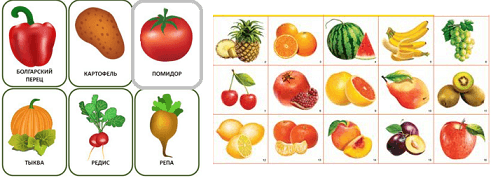
This way, they can correctly answer the question, "Are there more dogs or black dogs?" because they understand that one set may include the other. The session is also launched online during specific transactions. Now, instead of using a random method to organize items or information, children have the opportunity to use consistent criteria to order items. Decentralization is another distinctive feature of this stage. Thus, your child can now more successfully take another's point of view and can consider more than one dimension at a time as long as considerations remain specific.
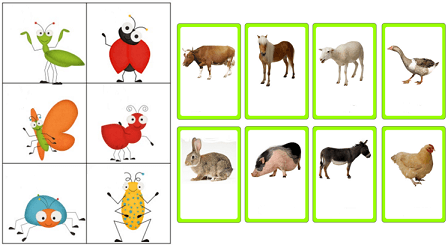
In addition, the child should already have the following skills:
- The baby eats with a spoon and fork, fastens buttons and zippers on clothes, and also knows how to tie shoelaces.
- Can complete tasks where you need to string large beads onto a thread.
- Easily draws pencil lines on paper.
- Can color coloring pages with smooth, straight lines without going beyond the contours of the picture.
- The baby knows where his right and left hand are.
Learning to count and write
To teach children 4-5 years old to write at home, it is best to use copybooks. You can buy a special notebook for your child, which will contain a wide variety of copybooks. The essence of the task for children is to look at the letter or number that is indicated at the beginning of the copybook, circle it on the dotted line and then write to the end of the copybook line yourself.
It can communicate more effectively about objects that the listener cannot see and can think about how others perceive it. A fun way to develop your perspective perception skills is through optical illusions. Additionally, your child may be able to understand more complex actions, such as when a person feels one way but acts another. These skills can also be seen in increased attention. That is, children of this age begin to understand that you can look at one thing and think about something else.
Watch this video that demonstrates how searching for one thing limits your ability to search for something else. As a result, they learn that they can shift and focus their attention with more control than before. Thus, at the age of 8-10 years, children learn to mentally combine, separate, order and transform objects and actions. They learn to conserve mass and area, and many also learn to conserve volume. Their ability to apply logic and reason increases, as does their ability to focus.
IN modern world Copybooks can be found not only in notebooks that contain such developmental exercises. You can easily find copybooks on the Internet and print them in any quantity for your child. It will be much cheaper than buying a specialized notebook.
They can consider multiple perspectives and employ a variety of thoughtful strategies. And although they continue to struggle with understanding abstract or hypothetical concepts, children this age can apply mental operations to concrete problems, objects and events.
What are developmental milestones?
Child development refers to how a child becomes capable of doing more complex things as they grow older. Development is different from growth. Growth only means an increase in the size of the child. When we talk about normal development, we're talking about developing skills like. Gross Motor: Using large muscle groups to sit, stand, walk, run, etc. Maintain balance and change positions. Great motor: use your hands to be able to eat, draw, dress, play, write and do many other things. Language: speaking, using sign and sign language, communicating and understanding what others are saying. Cognitive abilities: thinking skills: including learning, understanding, problem solving, reasoning and remembering. Social: interacting with others, communicating with family, friends and teachers, cooperating and responding to others' feelings. Developmental milestones are a set of functional skills or age-related tasks that most children can do within a certain age range.
You can teach your child to count using pictures where you need to count drawn objects. Usually up to ten identical objects can be drawn, and the essence of the task is not limited to counting. In addition to the fact that you need to count the objects, they also need to be painted, and, perhaps, something needs to be completed. Such tasks not only teach you how to count, but are also great for developing imagination.
General development - gross and fine motor, language, cognitive and social skills
Your pediatrician uses milestones to help check how your baby is developing. Although each milestone has an age level, the actual age is when it's normal developing child reaches this milestone, maybe very little.
Social and emotional development
What if my child does not reach his developmental milestones. If your child is delayed, you should begin intervention as early as possible so your child can achieve the best outcome.
Distinguishing colors
In order for children 4-5 years old to develop the skill of distinguishing colors, they will be greatly helped by educational cards on which they need to complete something and indicate what colors of pencils can be used to do this.
Cartoon about Bulldozer. Learning colors. Cartoon coloring book about Truck Leva
Developmental milestones for children born prematurely, from birth to 18 months, with information about exceptions and problems. This site will also help you determine your corrected age. premature baby. They offer excellent advice and information to parents about infant and toddler development. Early Head Start is for low income children, children younger age and pregnant women and their families. From zero to three is the leading resource in the first three years of life. . Finding an activity to keep your five year old busy can be quite a challenge.
Also very interesting option This exercise will include coloring pages and assignments for them. The child will need, for example, to color the animals in the picture. The one on the right in the coloring picture needs to be colored blue, the one in the middle – yellow, and the one on the left – green.
Characteristics of 5 year olds
With a little imagination and an understanding of their unique characteristics, we've put together a variety of activities that can be fun and educational. Young children are curious and restless little children, filled with energy and enthusiasm. Therefore, it is necessary to be aware of your unique developmental characteristics.
Practical training is the most effective way teaching a 5 year old child. More confident about their motor skills, they can run and jump quickly, but can also be very clumsy. It is important to ensure that if you are using outdoor activities for five year olds, constant adult supervision is required.
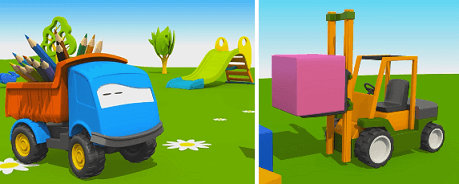
Distinguishing colors can be combined with learning numbers. You can ask the kids to count the characters on the card and name what color they are painted in. Also, the condition of the coloring card may say that you need to look at the drawing, which is divided into separate parts and numbers are written on these parts. Each number corresponds to a color that is written in the card's condition. You need to color the picture in accordance with the condition.
Five is also the year when children unleash their imaginations. Whether it's playing house with dolls or staging enemy attacks with their toy soldiers, kids love creating stories and letting their imaginations run wild. Since children this age are constantly asking questions, this is a good time to expose them to new concepts.
Various activities for 5 year olds
These activities will help in developing their character and in identifying their own likes and dislikes. Grab a pen and paper and sit down to write, like you tell five-year-old girls to make up a story. This activity is a great way to help them become more creative as they learn to think out of the box. They can play gym in the jungle, solve puzzles and learn to read time. They also love to play with toys and other board games.
Logical thinking
In order for children to develop, they need to be offered the following set of tasks:
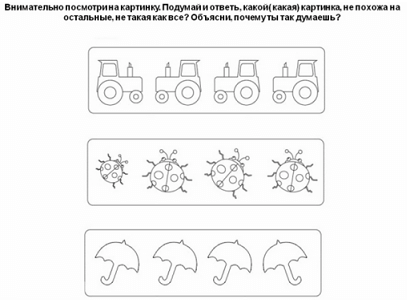
- Pictures between which you need to find similarities and differences.
- Look at the example drawing and fill in what is missing in the figures or other characters. This way the baby will learn to look at and follow the pattern.
- Kids are asked to connect objects with lines that form logical pairs. For example, a toothbrush and toothpaste, cup and saucer, etc. A variation could be educational cards for the home, where the child must establish the logic of events from the pictures.
- The “labyrinth” exercise for children 4-5 years old has also worked well. First, you can move the pencil over the drawing, and later you can put the pencil aside.
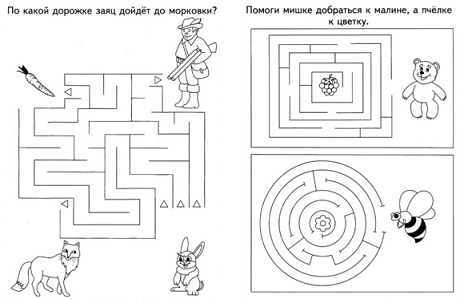
Activities for five-year-olds may also include helping them with daily activities. Learning to type or write is one of the most difficult motor skills your child will learn. Becoming an effective writer will allow your child to express their thoughts and ideas easily and clearly when they start school. The basics of drawing and using a writing instrument begin to develop between ages 1 and 2, and most children can print all the letters of the alphabet by age six.
It is important for children to develop the basics of writing skills as early as possible. Children with writing problems are at much higher risk for poor self-esteem, frustration at school, and academic failure. Once a child is in 1st or 2nd grade, it is much more difficult to correct spelling problems, so it is important to ask for help early if your child is struggling.
- Comparing which object is longer and which is shorter is also a great task for a child. It is easy, but at the same time trains observation and logic. In this type, you can also use larger-smaller, higher-lower drawings.
Speech development
For a 4-5 year old child vocabulary reaches a thousand words, and he can already construct long phrases of 6-8 words. To develop 4-5 year olds at home, you can ask your child to describe the object drawn in the picture, name its color, shape, say whether it is edible or not, etc.
The following are some typical stages in the development of printing and handwriting. As are some red flags that may indicate a problem. If you have problems with your child at any age, please contact us to speak with a professional. You can also contact our center at any time.
Between the ages of 18 months and 2 years, your child will
Try to hold the pencil with your fingers and thumb, but still use your entire hand to color.
Red flags for printing and handwriting creation
- Imitate you by scribbling with a pencil or pencil.
- Start making marks with the pencil rather than hitting it.
- Collect his own sketches on paper or other surfaces.
- Hold the pencil in your fist.
- Paint or color without going beyond a large sheet of paper.
Games for speech development in children 4 - 5 years old
To develop speech, you can learn the words of a short song and sing together. You can use a picture of an animal and name parts of the animal's body, but you must make sure that your child names everything correctly.
Between the ages of 2 and 3, your child will
However, he prefers to eat or swing pencils instead of writing with them. Hold the pencil with your fingers, but the pencil can be on the top of your head or handy when coloring.
- It is impossible to take a pencil and scribble on paper.
- Imitate you by drawing a vertical line - after about 2 years.
- Draw different strokes, dots and circle shapes.
- Use paints and a brush.
- Imitate the horizontal line pattern - after about 2 ½ years.
- Imitate you to draw a circle - after 2 ½ years.
Educational pictures with several vegetables and fruits will also come to the rescue. Ask your little one to find the fruit according to the description. For example, the picture shows a pear, an orange and an apple, and you say that the fruit is orange, sour and round.
Coloring pages for children
Coloring books for children are completely different. You can buy pictures for your child with his favorite cartoon characters, you can print out educational coloring books with tasks for him yourself, and you can even download special programs for coloring pictures on your computer. Use the latter, computer programs, with caution, since the baby should not spend more than ten minutes a day in front of the monitor.
Between the ages of 3 and 4, your child will
- Does not draw or make marks on paper when provided with a pencil.
- You can't imitate drawing a straight line.
- Copy the horizontal line, vertical line and circle model.
- Trace around the edge of the base shape template.
- Imitate you drawing a cross - after about 3 ½ years.
- The mark is on top of a thick horizontal line without going out very much.
Color the coloring books. Horse coloring pages for children
If you know that the baby will be capricious, it is better to refrain from using the program and use good old felt-tip pens, colored pencils, paints and paper outline drawings at home. To make it interesting for your little one to color, you can come up with rhymes or educational songs about the characters in the drawing.
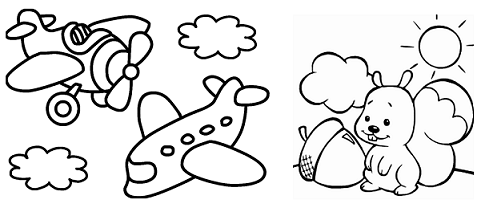
Development of attention in children
To develop children’s attention, offer them interesting tasks, for example:
- Show the child a picture where one image is mirrored to another, exactly the same. Find the differences in the pictures and color them.
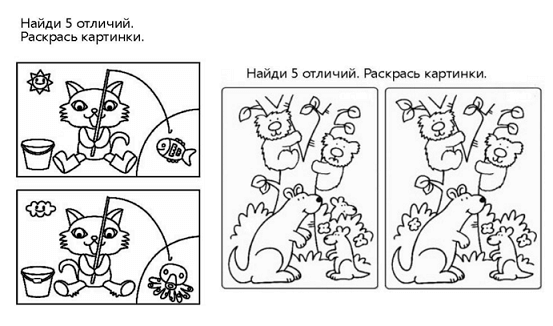
- Offer your child a picture of letters and ask him to color the same letters.
- Find identical objects in the picture and color them.
- Connect the dots and see what you get in the picture.
- You need to look at the characters in the picture and find whose shadow belongs to whom.
Math for kids
A child should learn the basics of counting and such a science as mathematics from childhood. The first tasks may be to count the characters in the image, but later the tasks should become more complicated.
The child must learn to compare two drawings and indicate where there are more or fewer objects. Mathematics, in particular addition and subtraction, can also be easily learned using a ruler. The baby can easily add 2+2, 1+3, and so on, if he has a real or drawn ruler.
We solve examples for addition 2+1=3. Fun math for kids. Short poems
A baby can gain first knowledge of geometry at the age of five by looking at pictures depicting flat and three-dimensional figures. He will be able to show which ones are which, and then later, at school, mathematics will not seem difficult to him.
Mathematics can also be easily studied using drawings as an example, where you need to count geometric shapes and name their color. To make mathematics easier to remember, you and your little one can compose songs about it and sing them in between tasks.
We bring to your attention a series of educational educational tasks in pictures aimed at preparing preschoolers for school
Task 1
Compare by size
The tallest of these three boys lives in the smallest house, the shorter boy in the longest house, the shortest boy in the tallest house. Draw an arrow from each boy to the house in which he lives. Color the ball with the longest string red, the ball with the shorter string blue, and the ball with the shortest string yellow.
Task 2
Choose by shape
Connect the dots in order. What geometric shapes did you create? Color them.
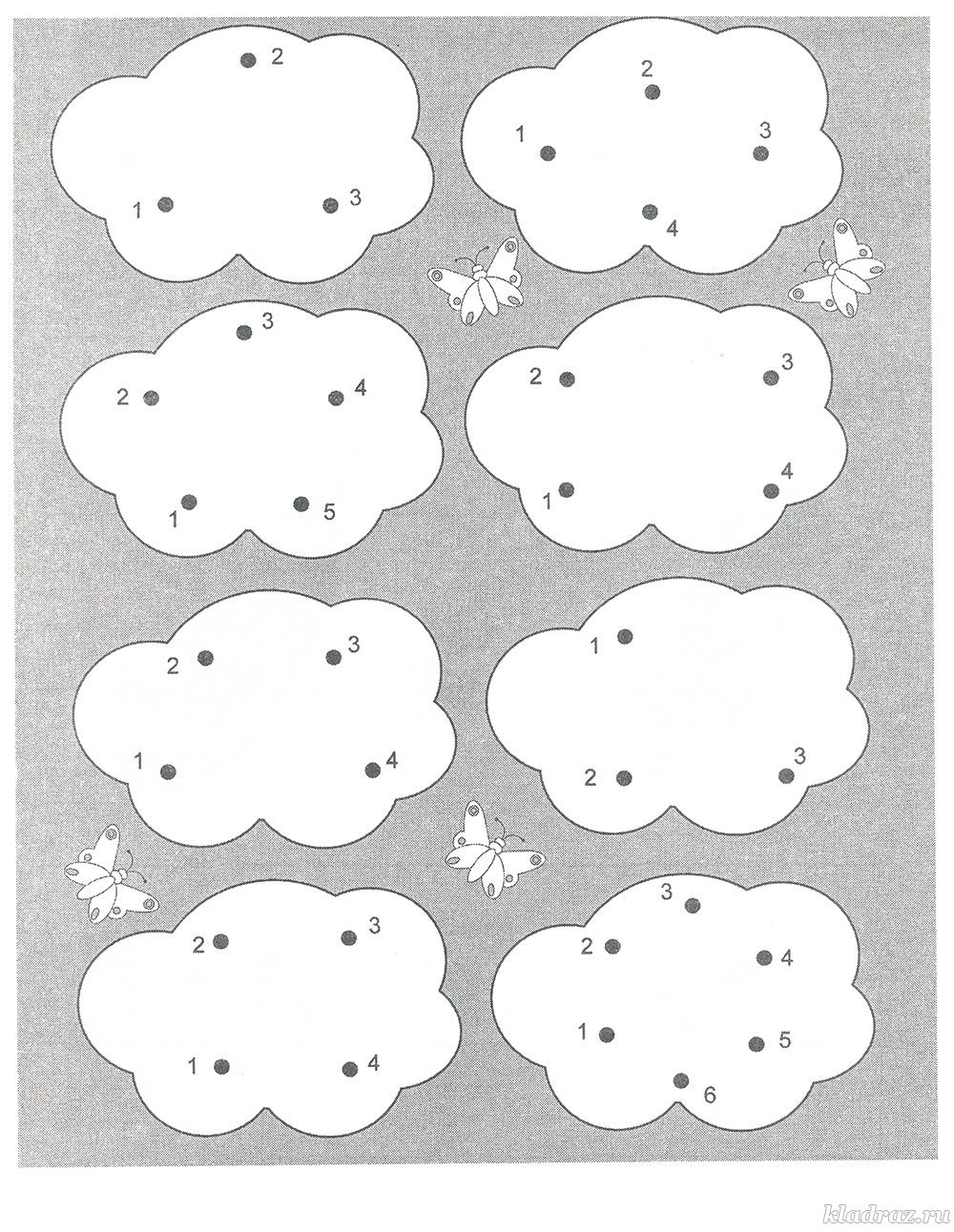
Task 3
Preparing your hand for writing
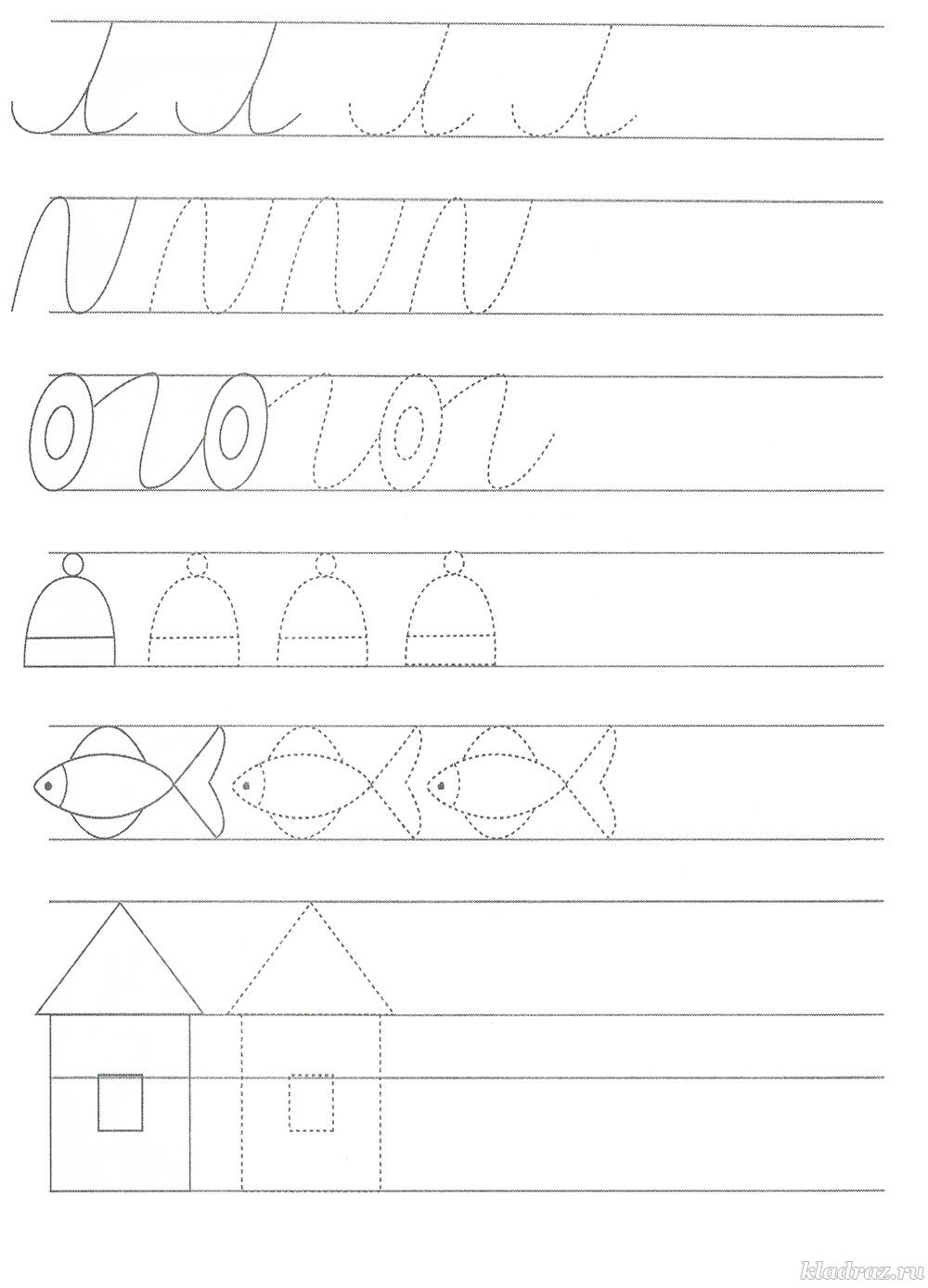
Task 4
Color page
What color are each of these items? What colors were mixed to create these colors? Show with arrows.
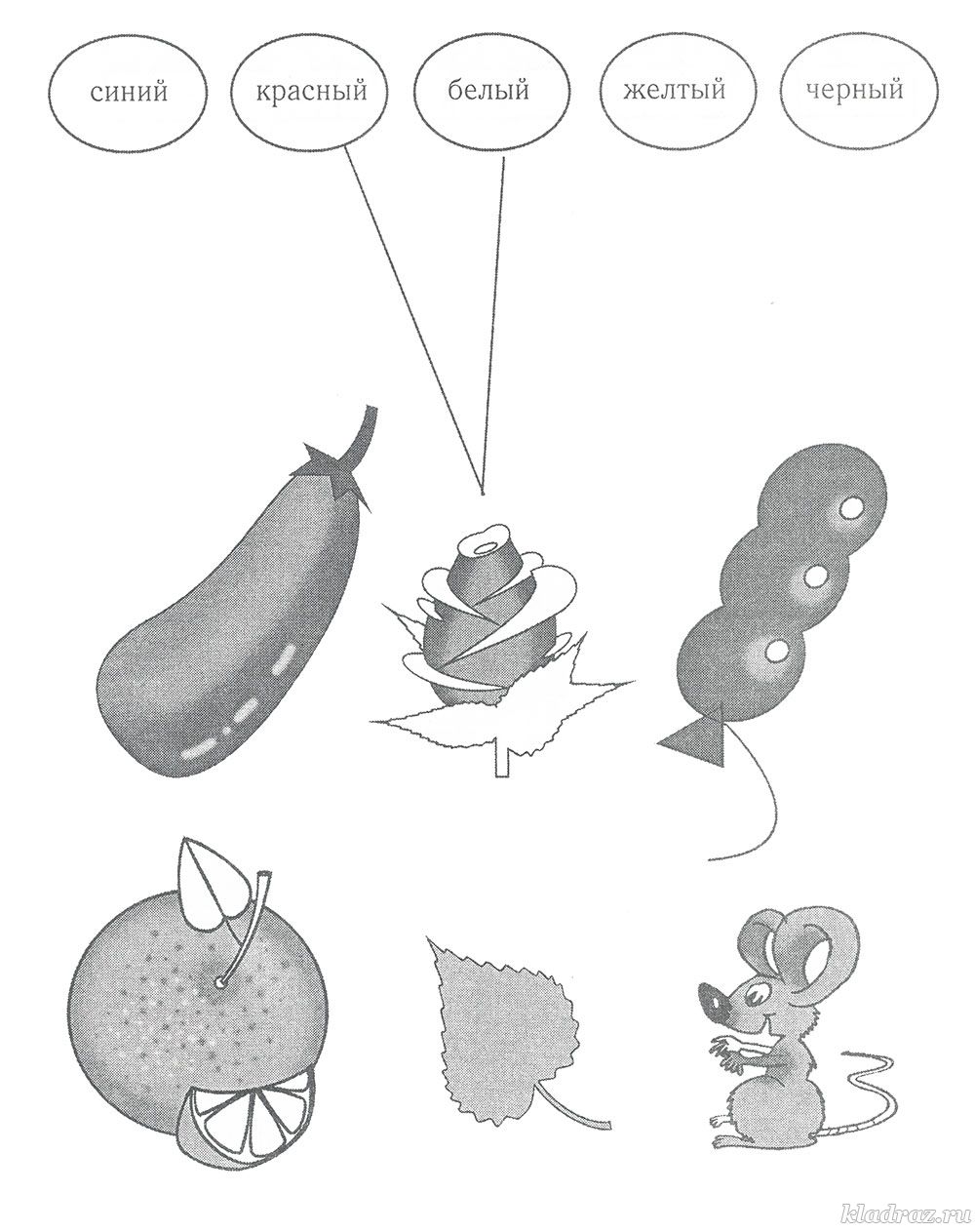
Task 5
Be careful
Count and write down how many times each figure appears.
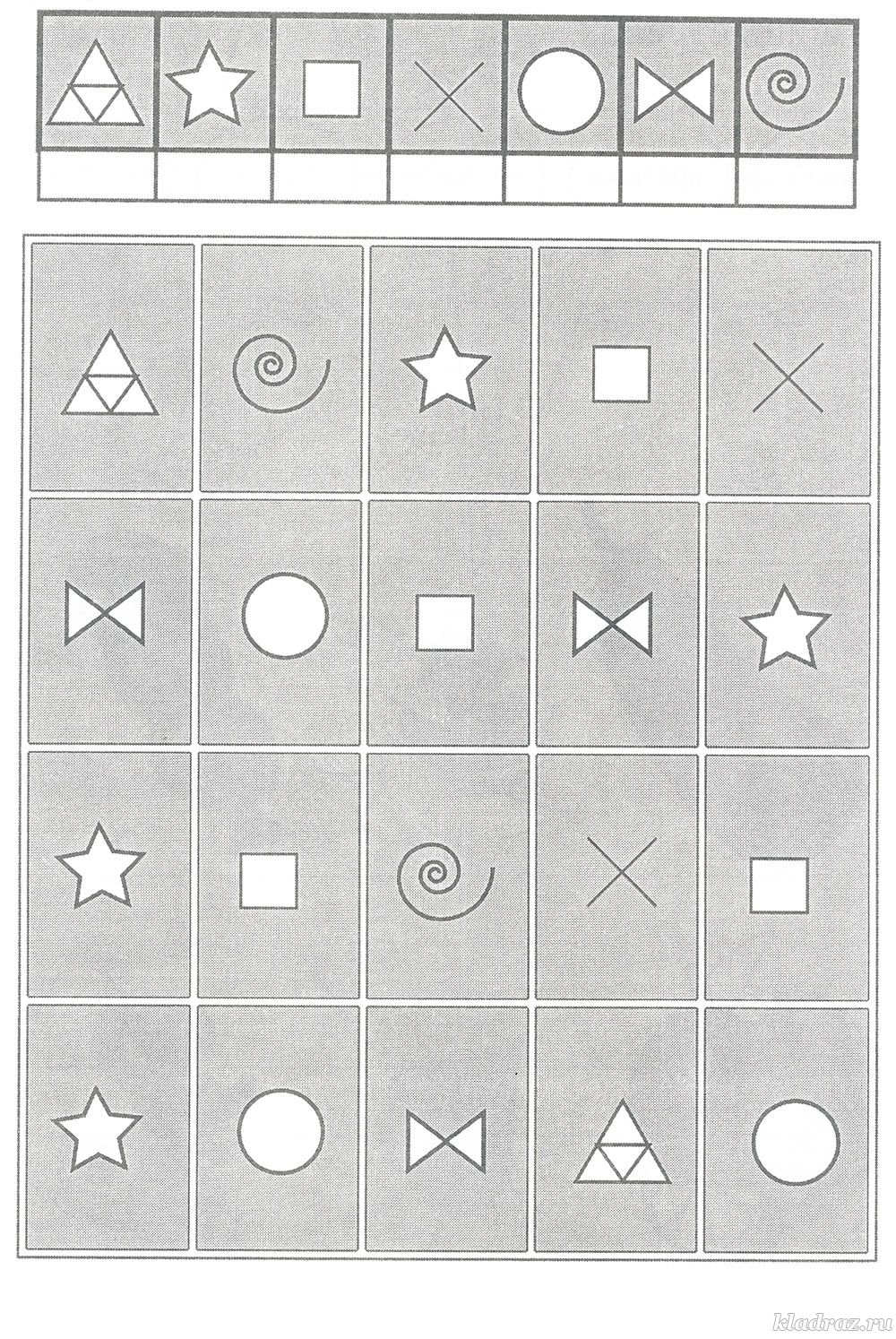
Task 6
Remember the pictures
Name and remember all the items in the table. When you remember, open the previous picture.
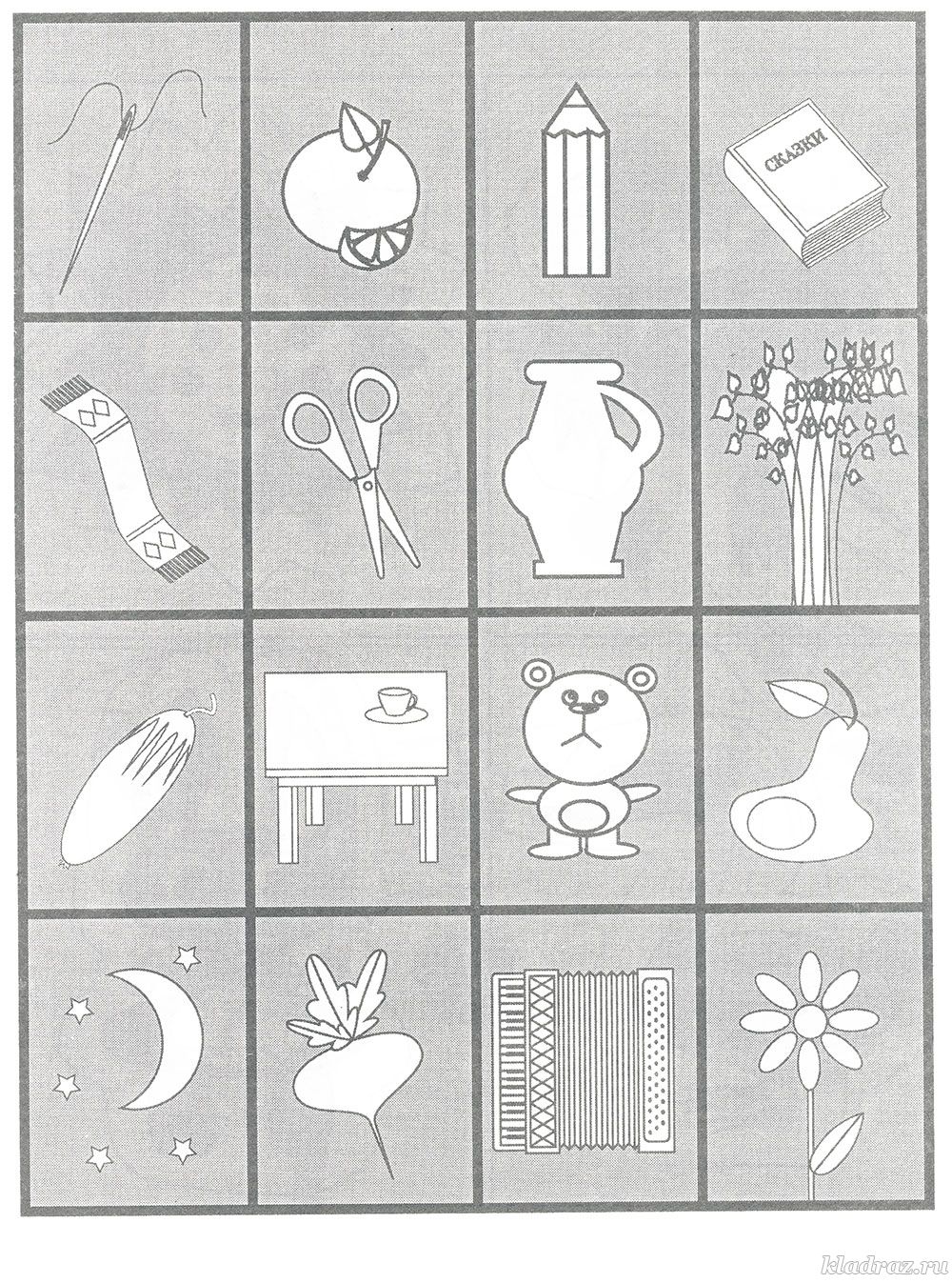
Task 7
Remember the pictures
Which items disappeared from the table, and which ones appeared again?
The beginning of the task in the next picture
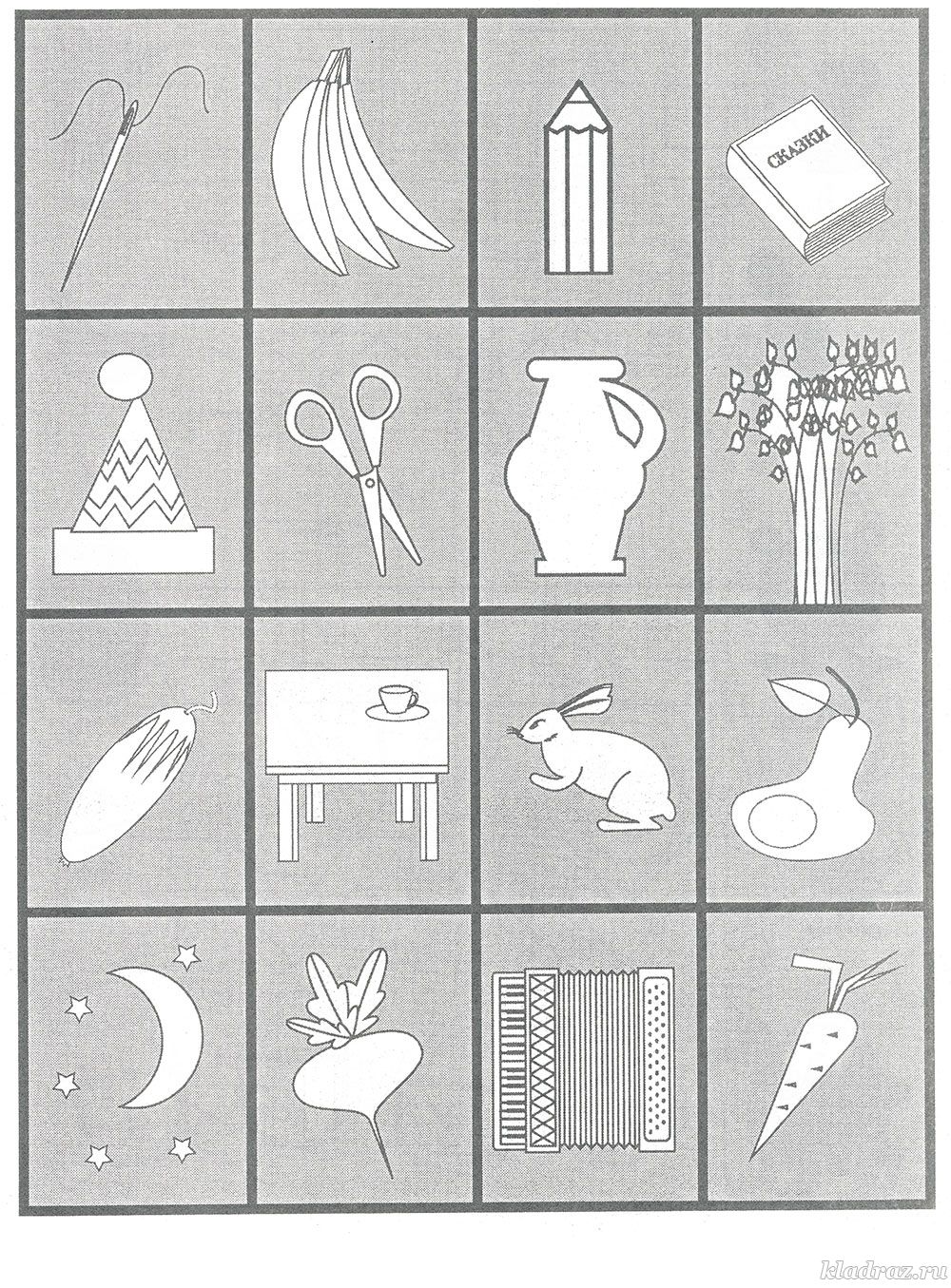
Task 8
Walk down the path
Circle the pictures first along the dotted lines, and then yourself.
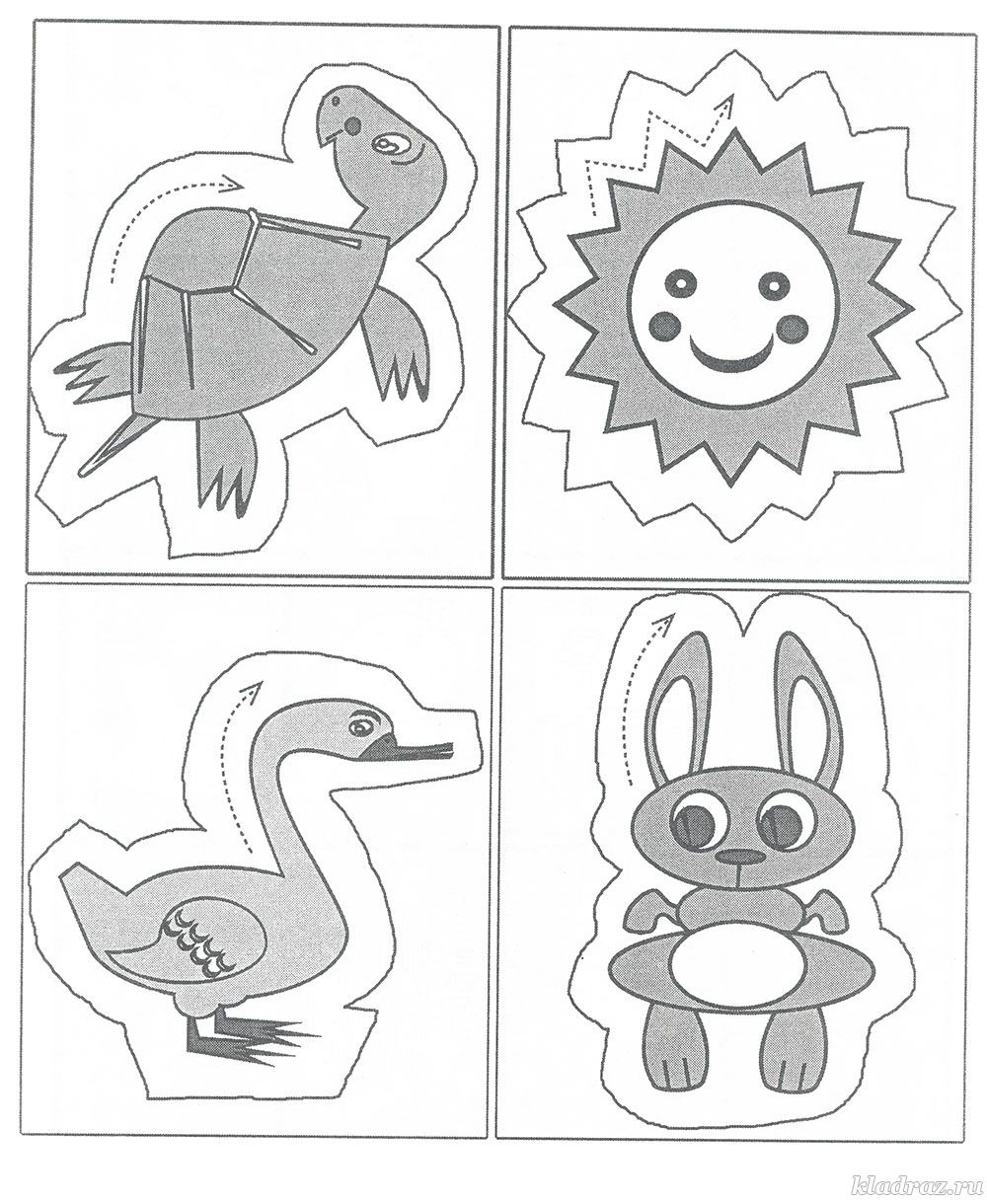
Task 9
Fun account
Count how many stars, how many leaves, how many berries, how many petals. Tell me how the numbers are made up.
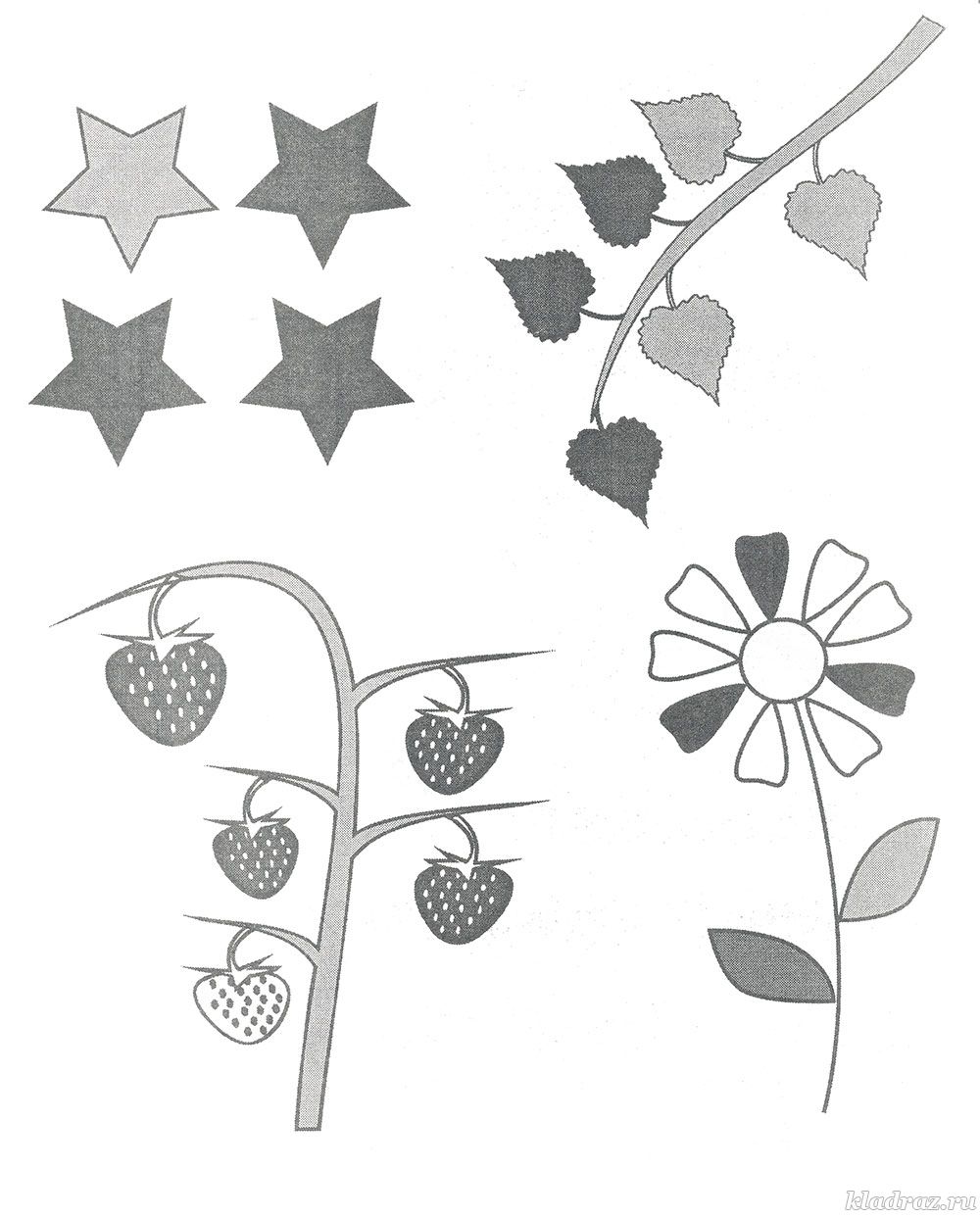
Task 10
What kind of cube can be glued from this blank?
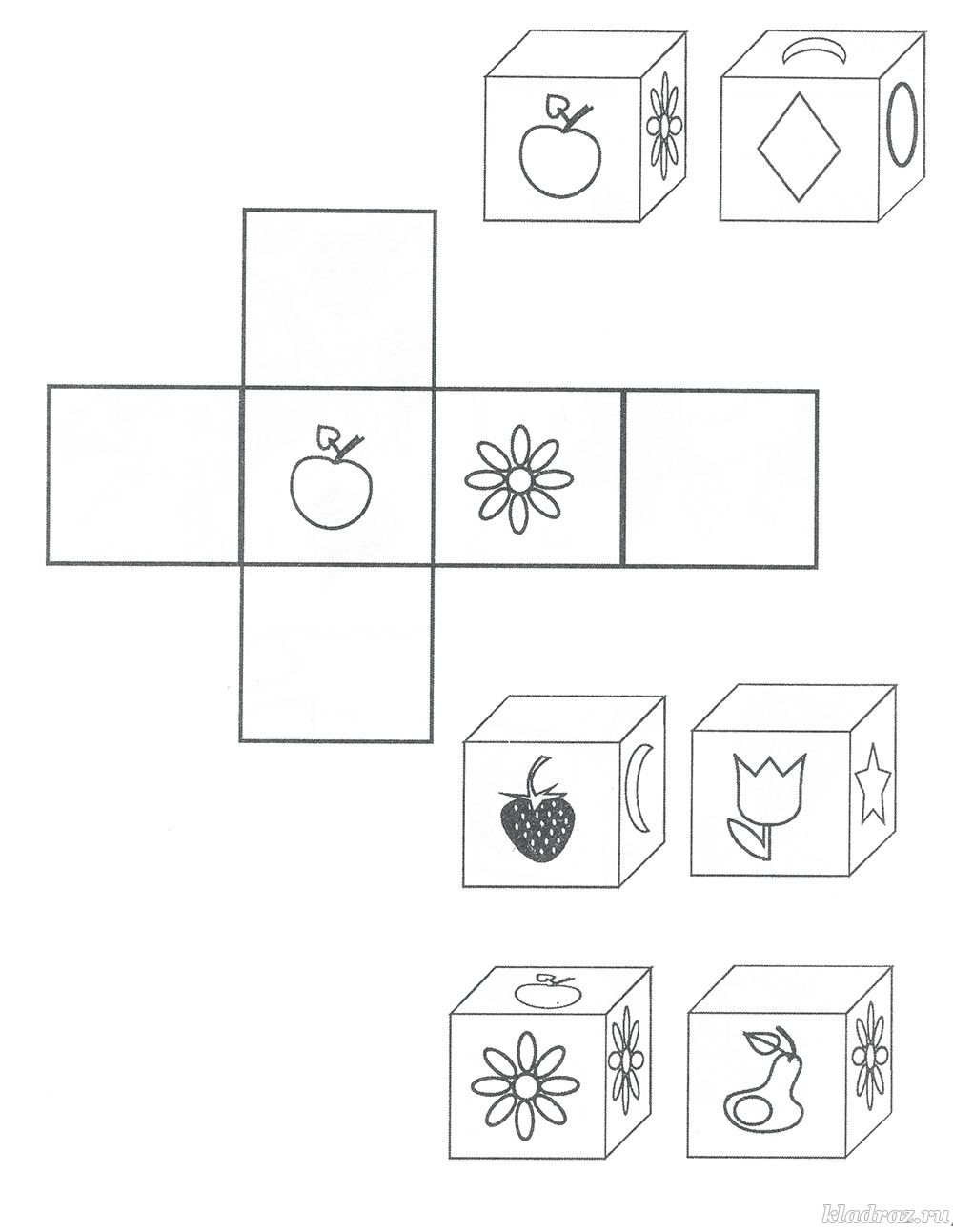
Task 11
Magic picture
Draw gradually increasing figures around the small figure, and gradually decreasing figures inside the large figure.
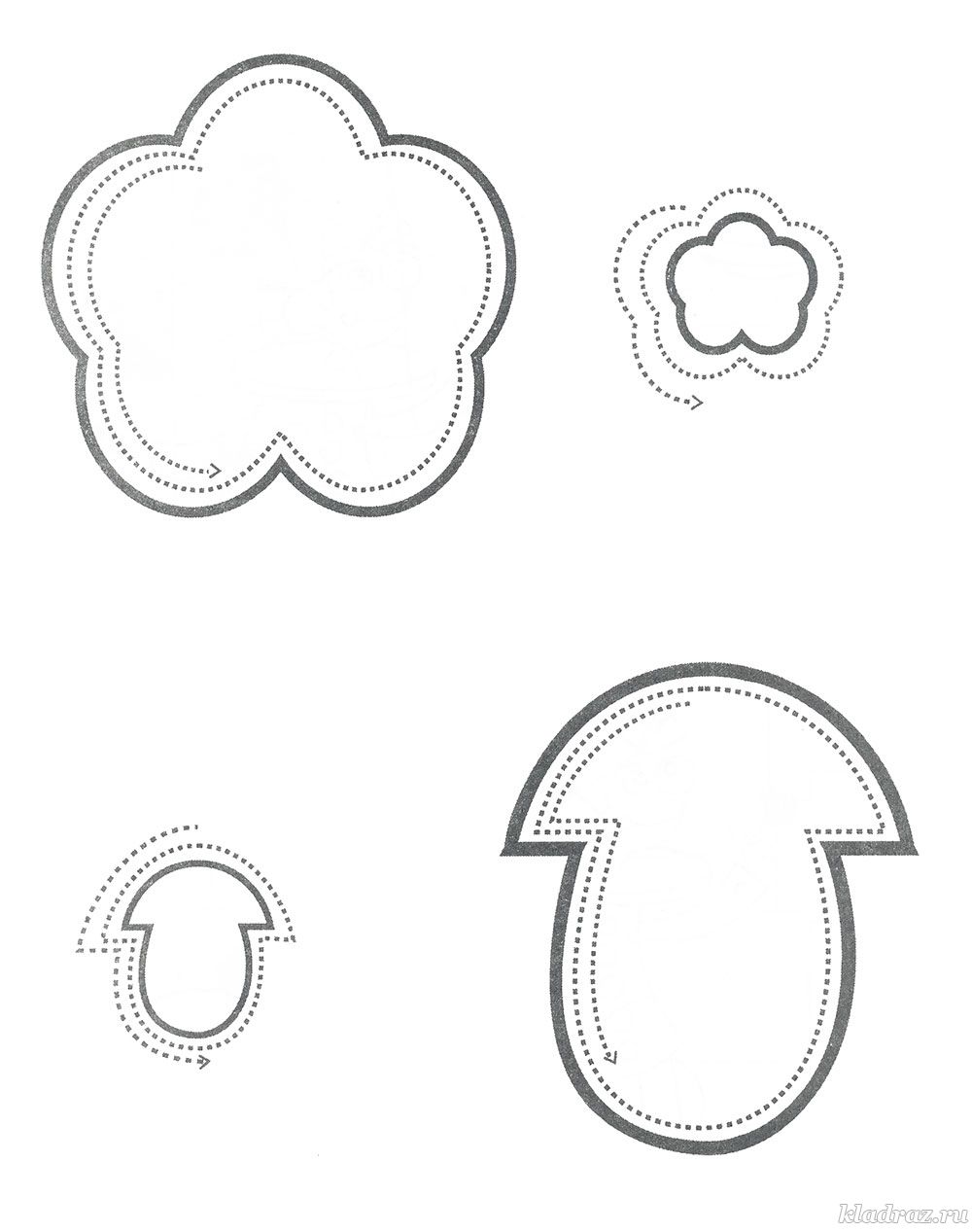
Task 12
Compare by size
Which clown has wide striped pants and which has narrow ones? Which ball has narrow stripes and which has wide stripes? Color the umbrella with wide stripes red and the umbrella with narrow stripes green.
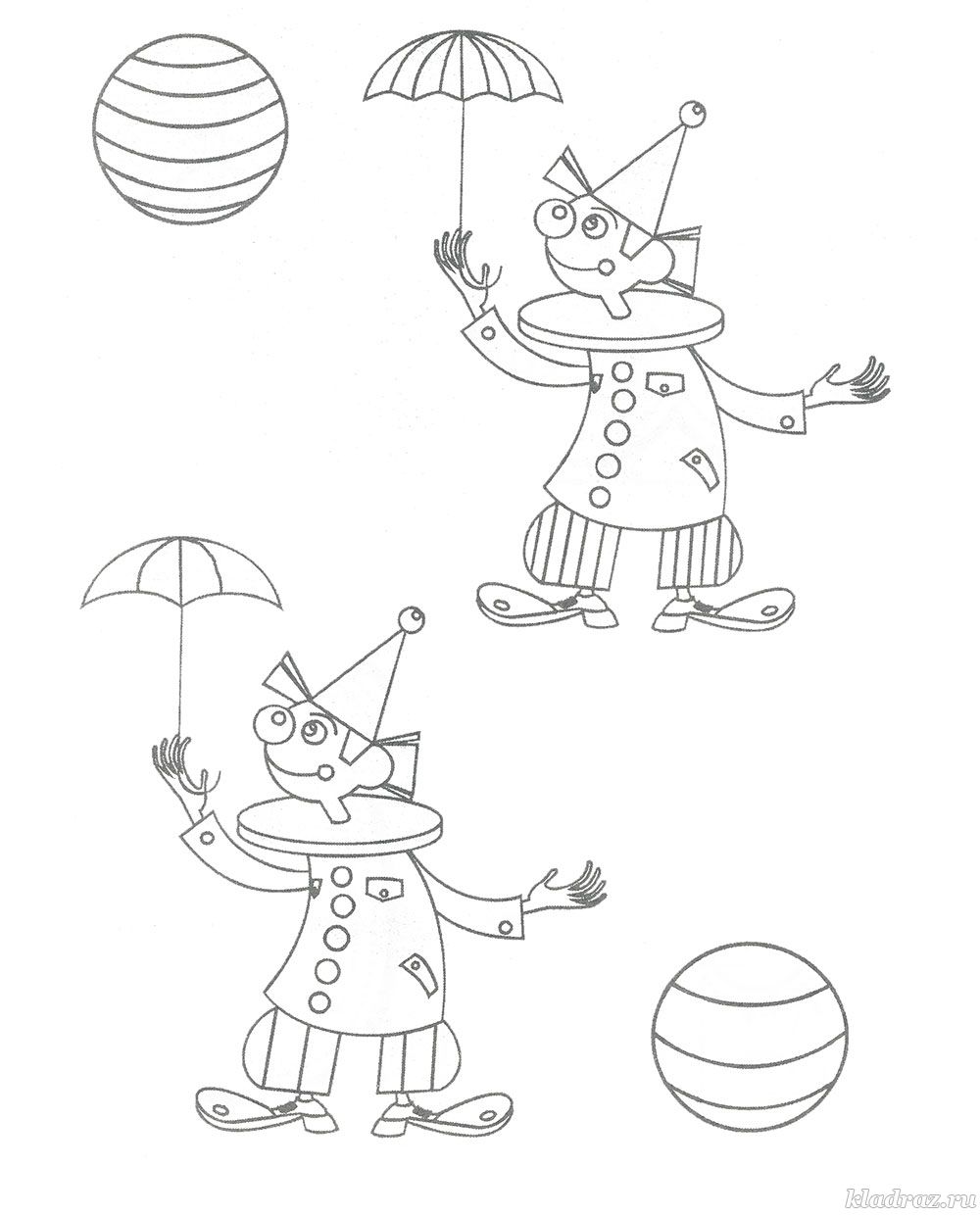
Task 13
Choose by shape
Find each one geometric figure its new place (walk along the line to the desired square and draw exactly the same figure in it).
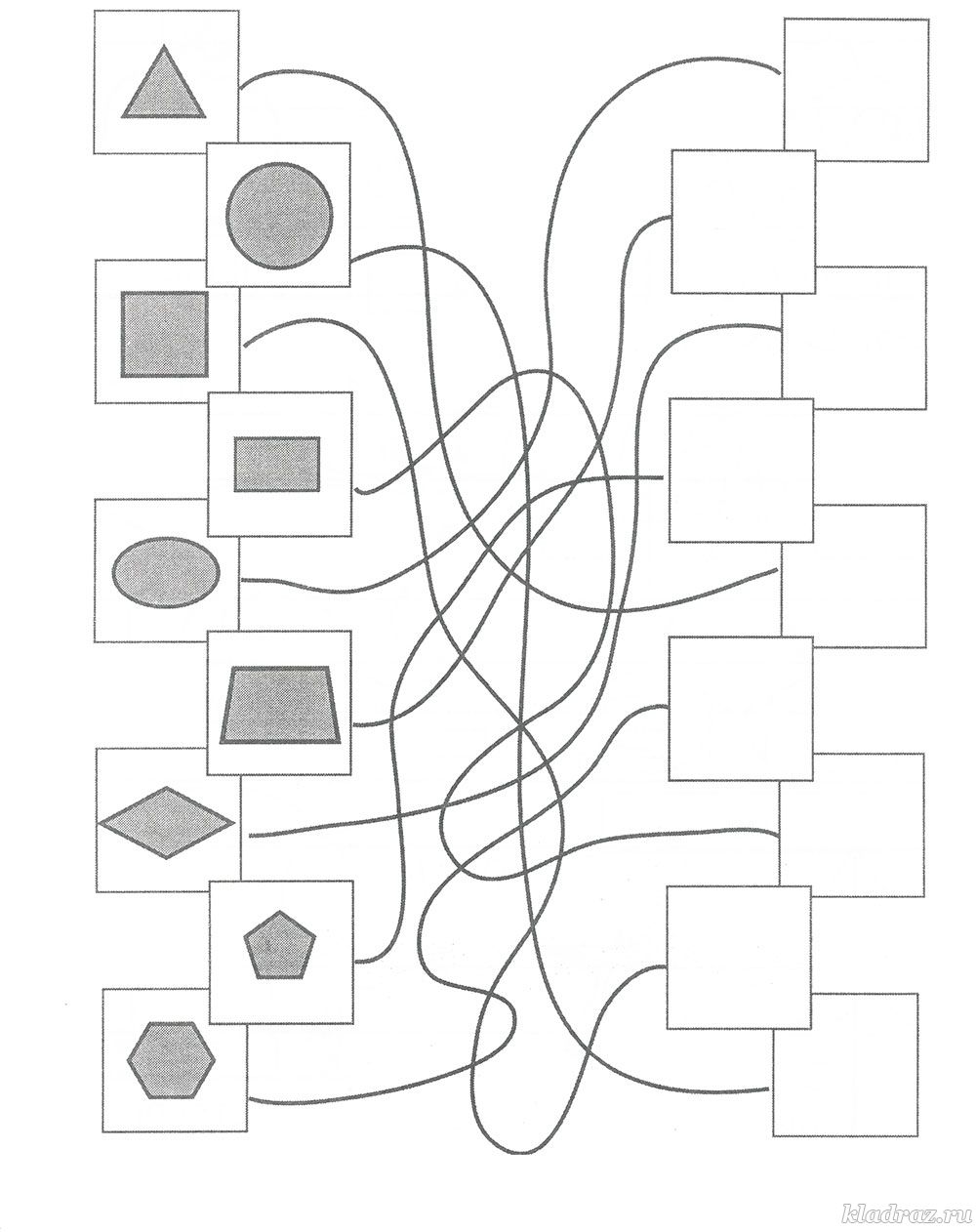
Task 14
Preparing your hand for writing
Finish the pattern and color the pictures.
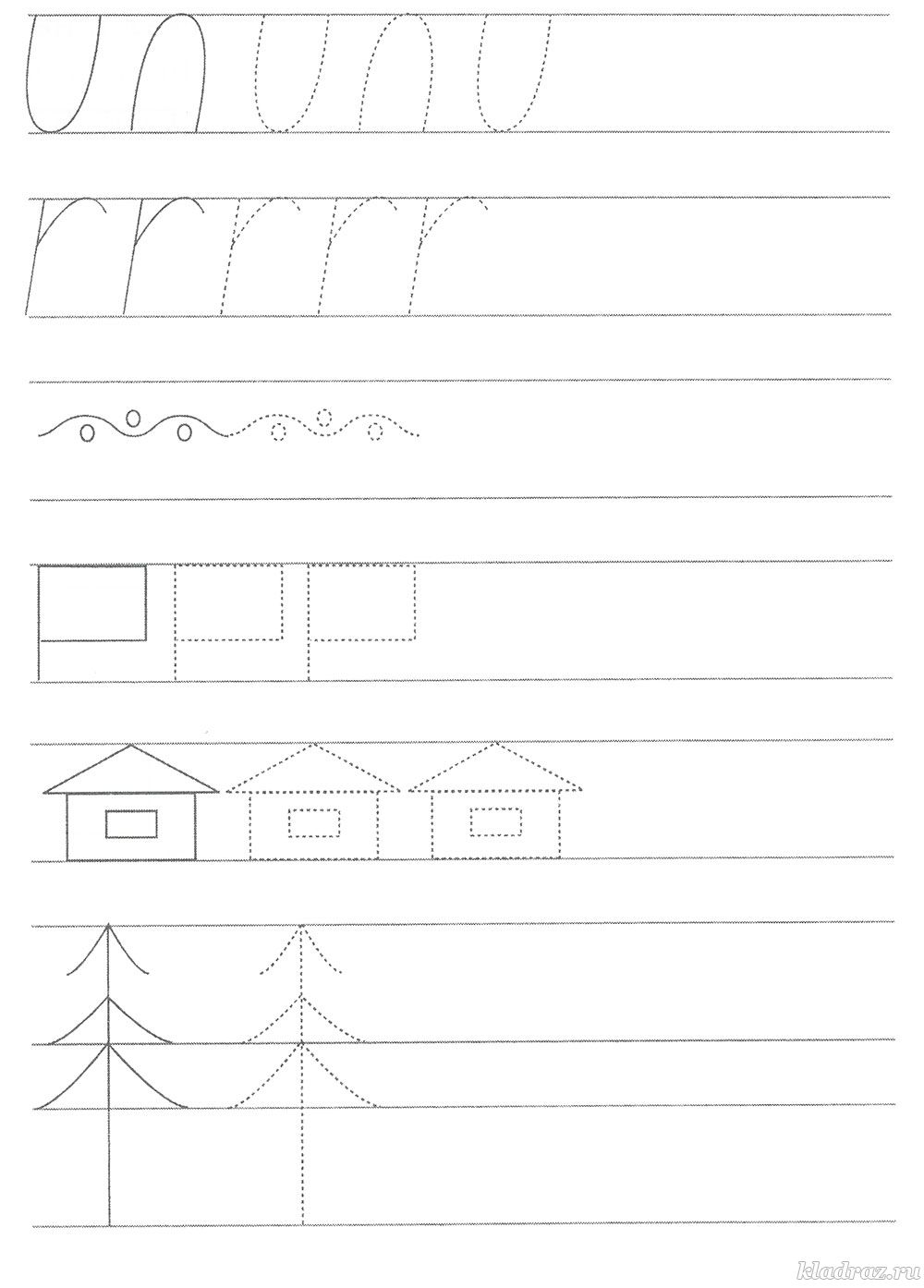
Task 15
Color page
The artist decided to paint the objects and chose these colors. What did the artist get wrong? Color the objects in the right colors.
![]()
Task 16
Be careful
Find a pair for each picture. Tell us how the different pictures are similar and how they differ.
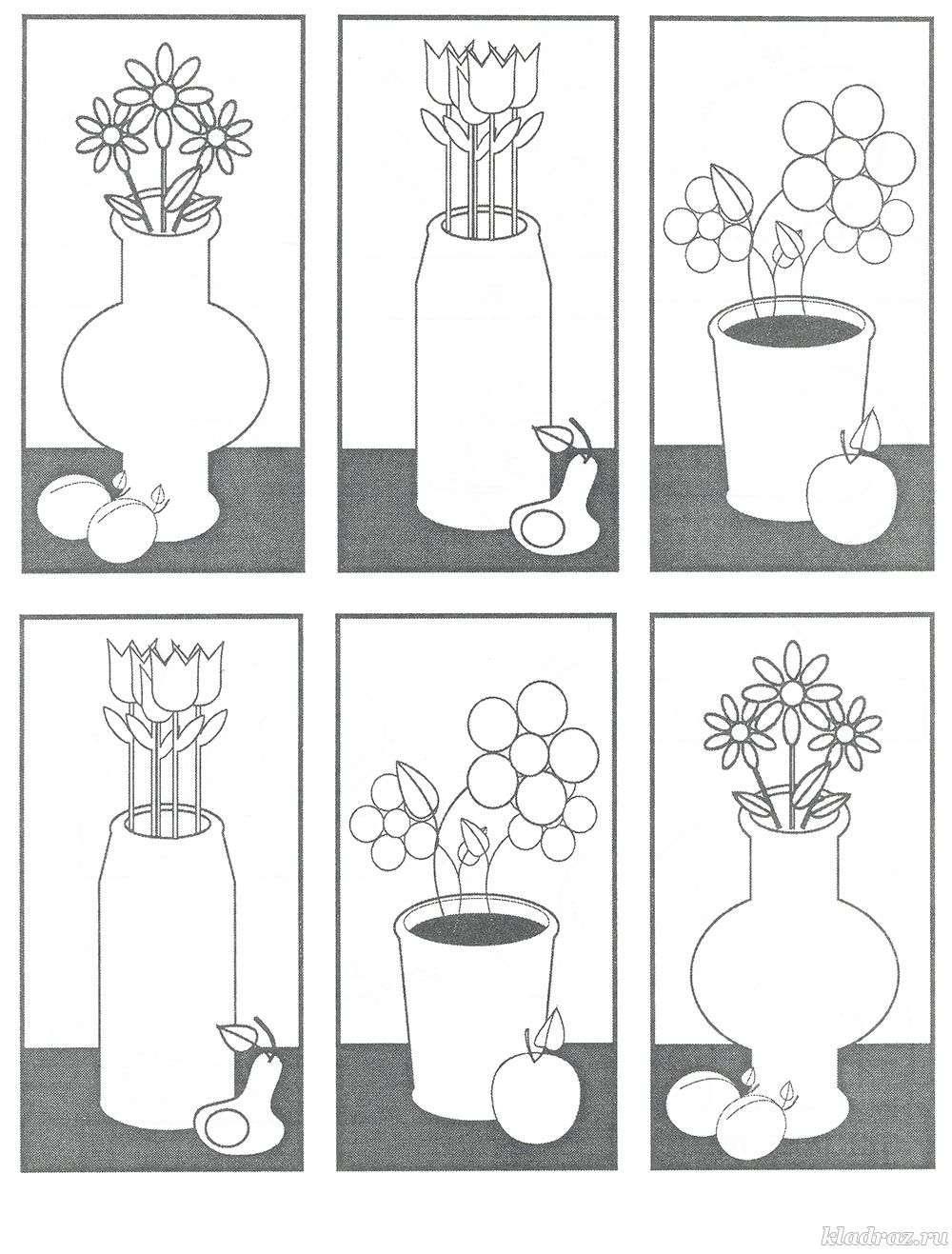
Task 17
Walk down the path
Help the animals walk along the paths.
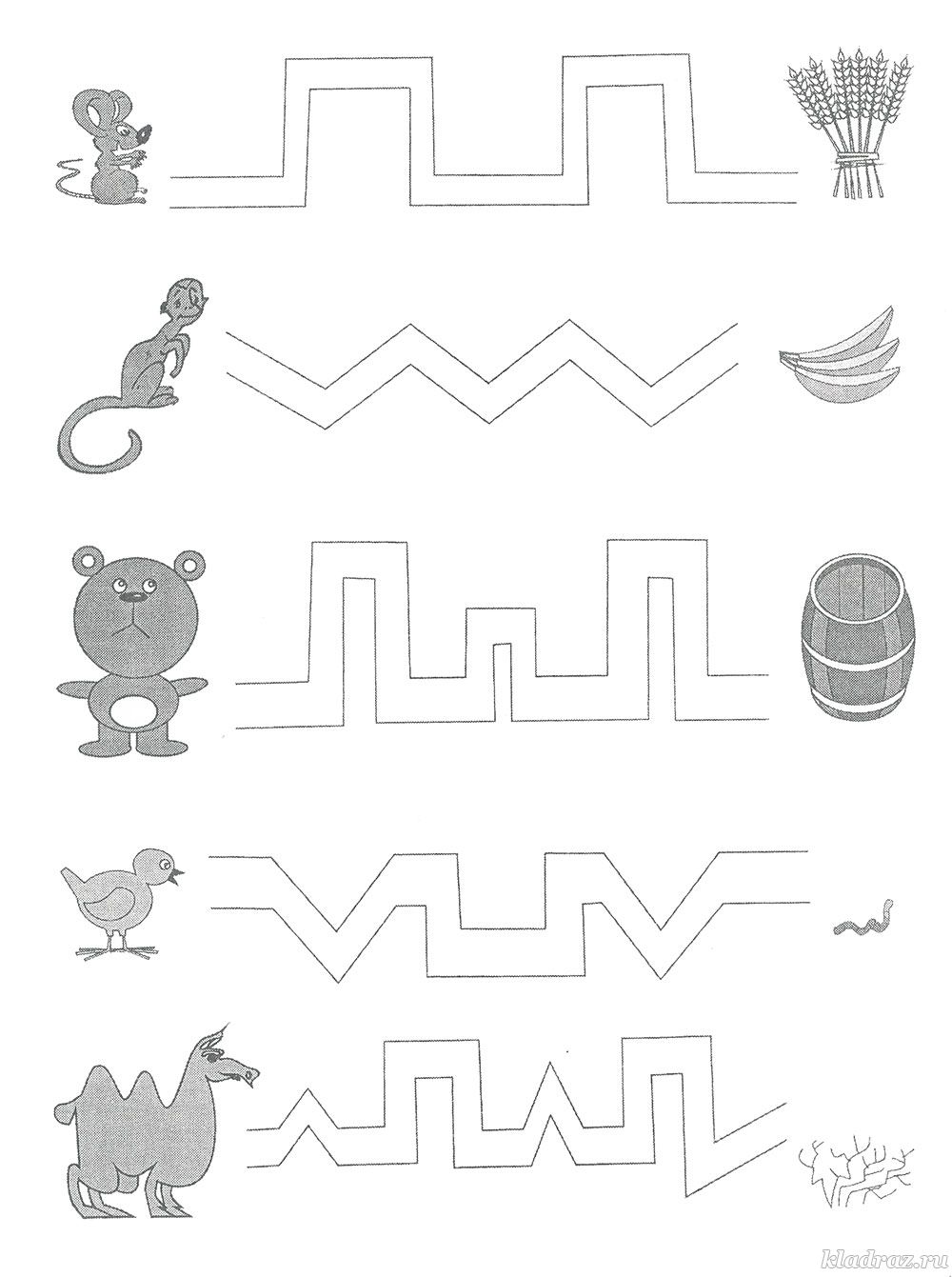
Task 18
Fun account
Will all the monkeys have enough banana?
Are there enough keys for all locks?
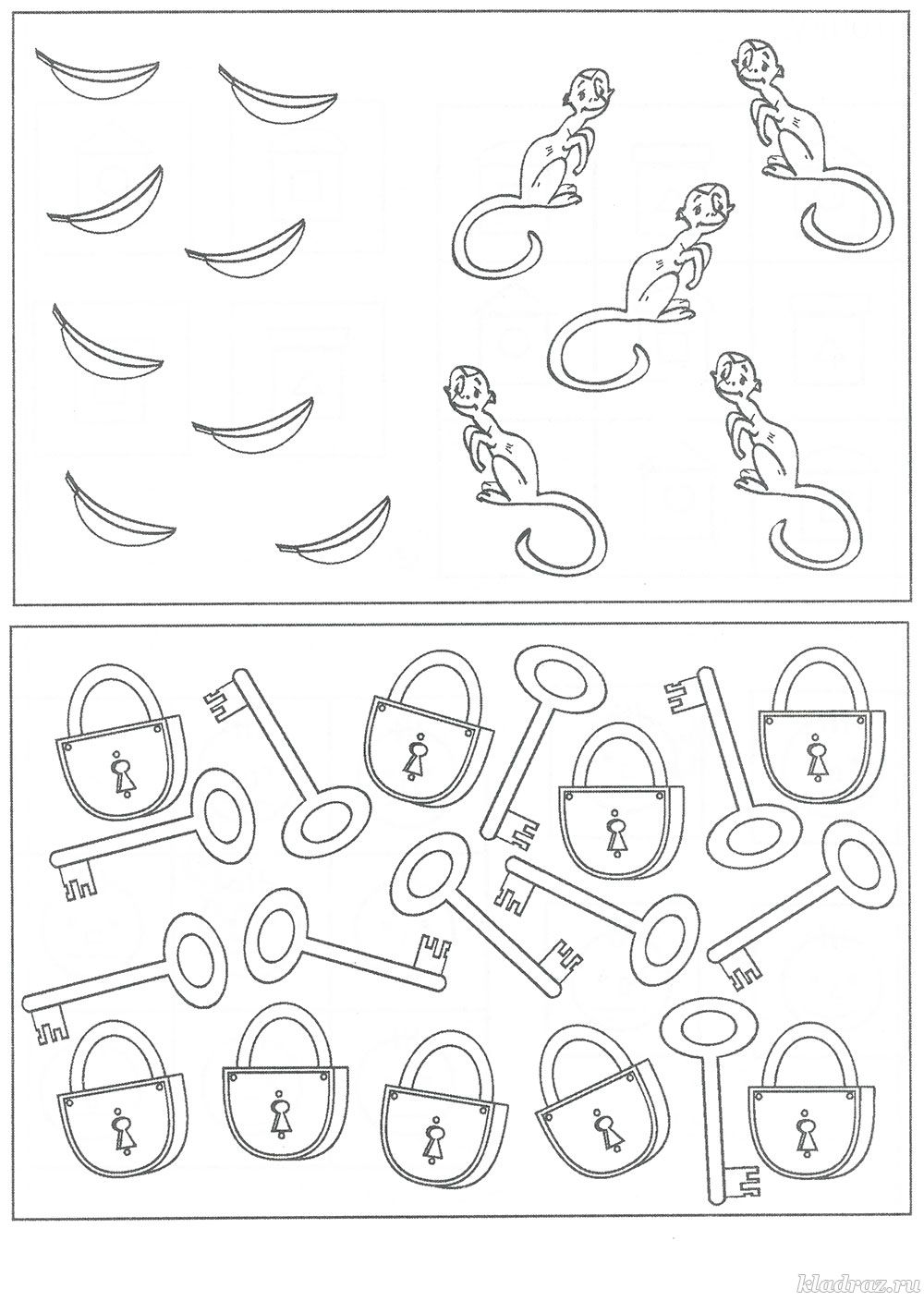
Task 19
Brain teasers
Without breaking the rules, choose from the proposed options the one that fits in the empty cell.
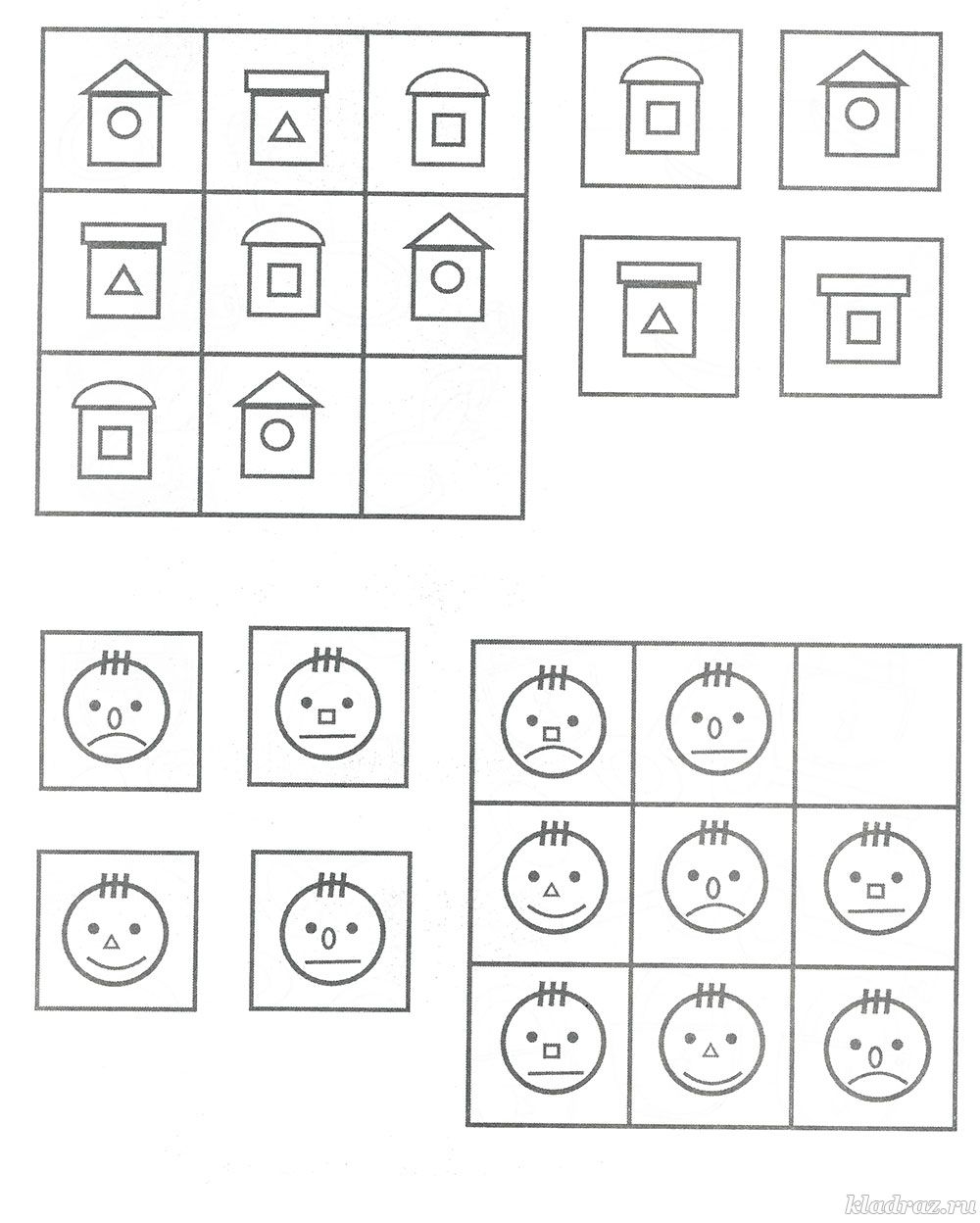
Task 20
Magic picture
Trace the picture dot by dot and color it.
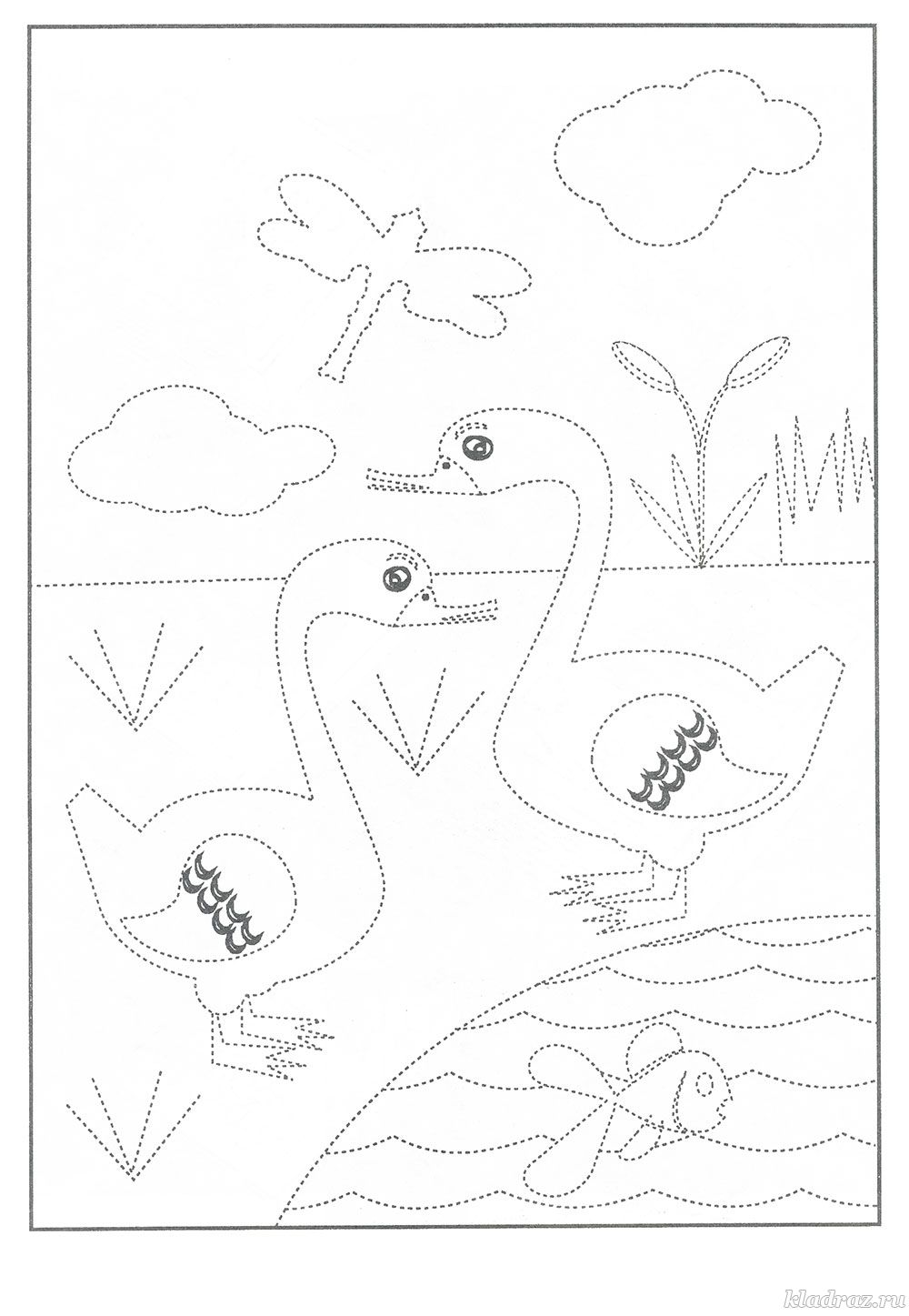
Task 21
Compare by size
Connect the books with arrows in order from thinnest to thickest.



